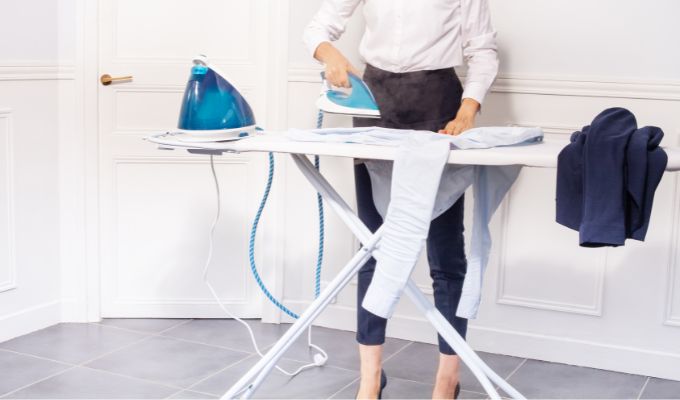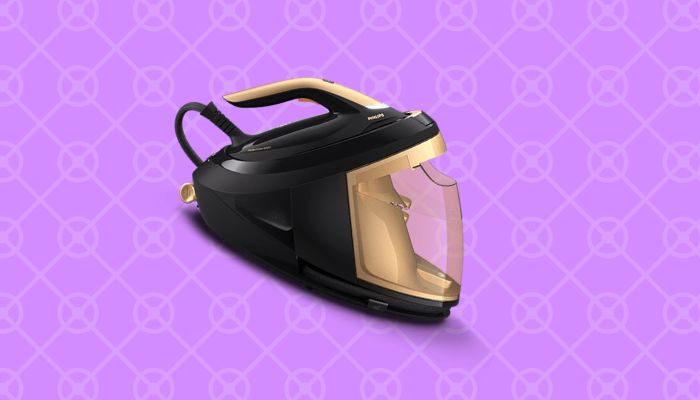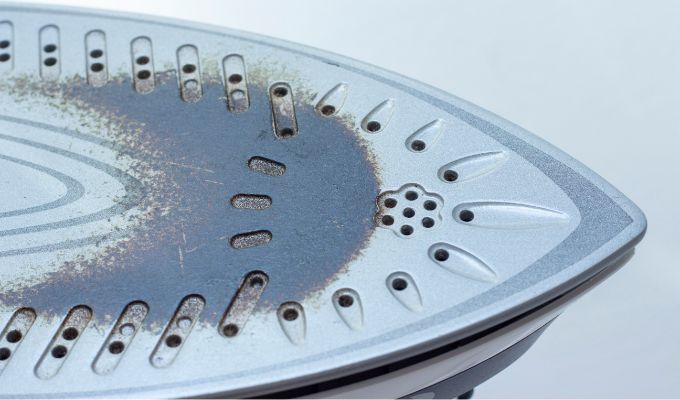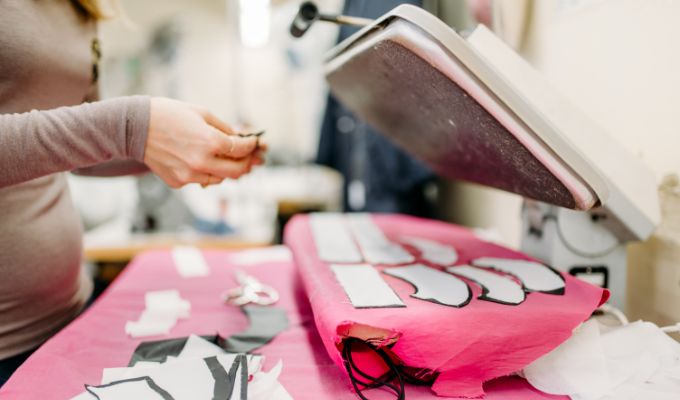The only thing more annoying than a leaking steam generator iron is having to iron clothes in a rush in the morning, and leaving water spillages all over them. Having discoloured water leak out only makes the matter worse.
A steam generator iron leak can damage an expensive garment or at the very least add more stress to an already stressful situation. What was ironing nicely as a smooth, wrinkle-free garment, has suddenly become a wrinkly, drenched disaster.
Now you’re in full panic mode – thinking your expensive (and much loved) steam generator iron may need to be binned, along with the stained clothes. But fear not, because every problem has a solution – here’s 6.
Common Causes of a Leaky Steam Generator Iron
To begin, it is helpful to understand why leaks occur so frequently in steam irons, so you know how to tackle them.
There are two basic causes of dripping irons. Initially, let’s talk about the temperature. It’s possible that you’re causing your iron to leak because you can’t wait for the heating chamber to reach maximum heat before you start ironing.
Your iron needs to reach 180–220 °Celsius before the water becomes steam vapour. To prevent your iron from leaking, all it may take is a little advance preparation and patience to pre-heat your iron before ironing.
The second issue could simply be down to some limescale or dirt build-up. The good news is that there are a plethora of quick fixes that won’t require you to throw away your beloved steam generator.
1. Iron Temperature is Too Low
Temperature plays a significant role in stopping leaks and drips, as was previously discussed. If the temperature of your iron is too low, it may dribble or leak.
At a temperature of 100 degrees Celsius, the water turns into steam. Without proper reaching this temperature, steam cannot form, and water will leak through the soleplate as you try to iron.
Wait for one to three minutes for the iron to achieve the ideal temperature before starting to iron. The “ready” indicator light will need to turn on, which requires waiting. Water, rather than steam, is released when the iron is not hot enough because steam has not had enough time to form.
Remember, the whole purpose of a steam iron is to turn water into steam, and a generator station amplifies this process, so you need to ensure all your settings are correct.
If the dial isn’t in the “steam” position, the iron won’t become heated enough to steam. Because of this, the soleplate may leak or spit when the steam burst is activated. Before you turn on the steam, make sure the dial is in the “steaming” zone. Then, rest the iron for a full minute to allow it to heat up before continuing.
This low temp issue can happen to both steam irons and steam generators, so the resolution steps are the same for both types of iron. If in doubt, verify that the temperature setting is correct by checking the user instructions.
2. Condensation Issue
It is possible for steam to condense into water in the hose when using it for the first time or after a lengthy period of nonuse. This water appears when the iron goes from hot to cold, forming natural drops of condensed water inside the hose.
Condensation is when water vapour condenses back into a liquid state. It develops when the air’s water vapour cools and turns from a gas to a liquid.
Condensation can occur inside your home as well as outside at any time of the year. It’s something that may happen anywhere: on your car or on the inside of your windows. We’ve all seen this in action, on walls and mirrors after a hot shower.
Well, the same thing can happen on the inside of the iron, particularly in the hose. So when you turn your iron on, some excess old condensed water can make its way out and onto your clothes, giving the impression of a leak.
To correct this issue, move the soleplate away from the fabric while pressing the steam trigger. Continue doing this until steam, rather than water, is coming out of the soleplate holes.
3. Limescale and Dirt Can Cause Leaks

Limescale
The efficiency with which an iron heats water is diminished if lime deposits have built up on and inside the soleplate. The more scale there is, the more difficult it is for the iron to heat the water to the proper temperature.
After a certain threshold of calcification, it is possible that no more water vapour will form. The level of calcification in your steam iron’s water tank is usually a good indicator of its condition. Then, deposits begin to accumulate on the inner margins, and they’re easy to see. If the iron has become heavily calcified, using the steam setting may cause small pieces of lime to fall out of the holes on the underside of the iron.
Descaling is the answer, even if your steam generator has an auto-de-scale system, the soleplate – around the steam exit hole – can still suffer will scale and dirt deposits. An over-the-counter descaler, or a combination consisting of equal parts vinegar and water, can be used for this purpose. Make sure the product you purchase can be used with a steam generator iron before you buy it.
Follow the directions on the descaling agent’s packaging to add it to the water tank. Vinegar essence is a natural cure that can be used instead of store-bought medicine. Fill the tank with a mixture of this and water at a 1:1 ratio.
- Start the iron and wait for it to heat up. Put it somewhere that can withstand high temperatures, such as the ironing board’s metal shelf or a metallic sink.
- Once the iron is fully heated, press the steam button for a few seconds to loosen the limescale in the lines.
- Turn the iron off and walk away from it so the descaler has time to do its job.
- About 20 minutes later, you can turn the iron back on.
- Turn on the steam and steam boost features and use them until the water tank is dry.
- To finish, fill the steam iron’s water tank with fresh water and empty it again to flush out any leftover descaler.
While iron cleaning isn’t high on anyone’s list of fun activities, it is necessary if you want your clothes to look freshly pressed, and to avoid leaks – particularly brown water.
This build-up can cause the iron to “spit out” water and create brown and white markings on your garments as you iron. Fortunately, iron cleaning is an easy fix.
When it’s time to give your generator iron a good cleaning, some models feature indicator lights. On the other hand, some models have descaling mechanisms internally. Although, manual descale may be necessary on the soleplate.
Dirt
Due to the build-up and blockages of dirt, dust, and lint on the soleplate, your iron may leak water after some use.
Dripping can occur when dirt, burned lint, or lime deposits build up on the soleplate holes of an iron. Soleplates typically only require a quick wipe down with some water or vinegar to look as good as new – unless you have a lot of burnt marks.
Water or vinegar on a rag, squeezed out, can be used to clean the soleplate in less severe situations. First, preheat your iron at its lowest setting – this will help soften deposits of grime.
Turn off the power and make sure the iron isn’t hot enough to burn – just warm, then use the damp cloth to scrub the soleplate. Keep your hands off the soleplate during cleaning – use the iron handle for support.
To avoid premature wear and possible damage to your iron’s soleplate, never use steel wool or other abrasive cleaning materials.
4. Wrong Water Use
Using scented or flavoured water with your steam generator iron is not recommended. In order to get the most out of your steam generator, only use regular tap water. Mixing tap water with distilled water is recommended if the water in your area is considered hard.
You might think that using purified water instead of tap water would yield better results, but that’s not the case because distilled water on its own has a harder time turning into steam. And if the iron isn’t able to vaporise water into steam, your iron will leak water, instead.
The optimal solution is to use plain clean tap water if you’re in a soft water area, or a combination of 50% tap water and 50% distilled water if you are in a medium/hard water zone. You must, in the end, abide by the instructions provided in your steam iron’s user manual. Even though most irons work just well with tap water, you might be told to use a 50/50 mixture in the instruction – check.
5. Steam Boost Overuse
Overdoing the steam blast function can give the impression of a leak. It’s not recommended to excessively use the steam burst, although it’s tempting to blast your way through those tough creases.
You should push the button sparingly, not on every pass.
Wrinkles and creases are the sole targets of this function. To prevent leaking that will result in a damp disaster, you should provide plenty of time for pressure to build up between bursts.
6. It’s the Ironing Board
You should iron on an ironing broad specially designed for steam generator irons, with an appropriate cover. If the steam isn’t able to pass through the fabric you’re ironing, and then through the cover and ironing board, the steam will become trapped between the fabric and ironing surface, resulting in soaked patches, clearing the appearance of a leak.
Never use a steam generator iron on a table or kitchen worktop, because the steam can’t escape.
An ironing board is more than just a flat ironing surface that holds your steam iron at the right height, it optimises steam flow to keep fabrics dry and improves wrinkle removal.
Leaking Stean Generator Troubleshooting Summary
- Ensure your iron is set at a high enough temperature for it to generate steam
- Assess for the possibility of condensation
- Ensure your soleplate is clean and clear of dirt, dust, burnt-on lint, and limescale
- Ensure you’re using the correct water rated for your steam generator – no flavoured, bottled, undiluted distilled, or fragrance water
- Don’t overuse the steam blast function
- Iron on the correct surface with a suitable ironing board and cover
In most cases, a small amount of investigation will reveal that the root of your iron’s leaking problem is rather simple. Leaks might put a dampener on your day, but regular cleaning and the correct operation can keep your steam iron working perfectly for many years.
If you’ve gone through all of these troubleshooting steps and your iron is still leaking, you could have a damaged hose or defective part, particularly if your leak is around the boiler water tank, and not the soleplate. If you suspect damage, contact the manufacturer to arrange inspection and repair, which should be covered by your guarantee if valid.



